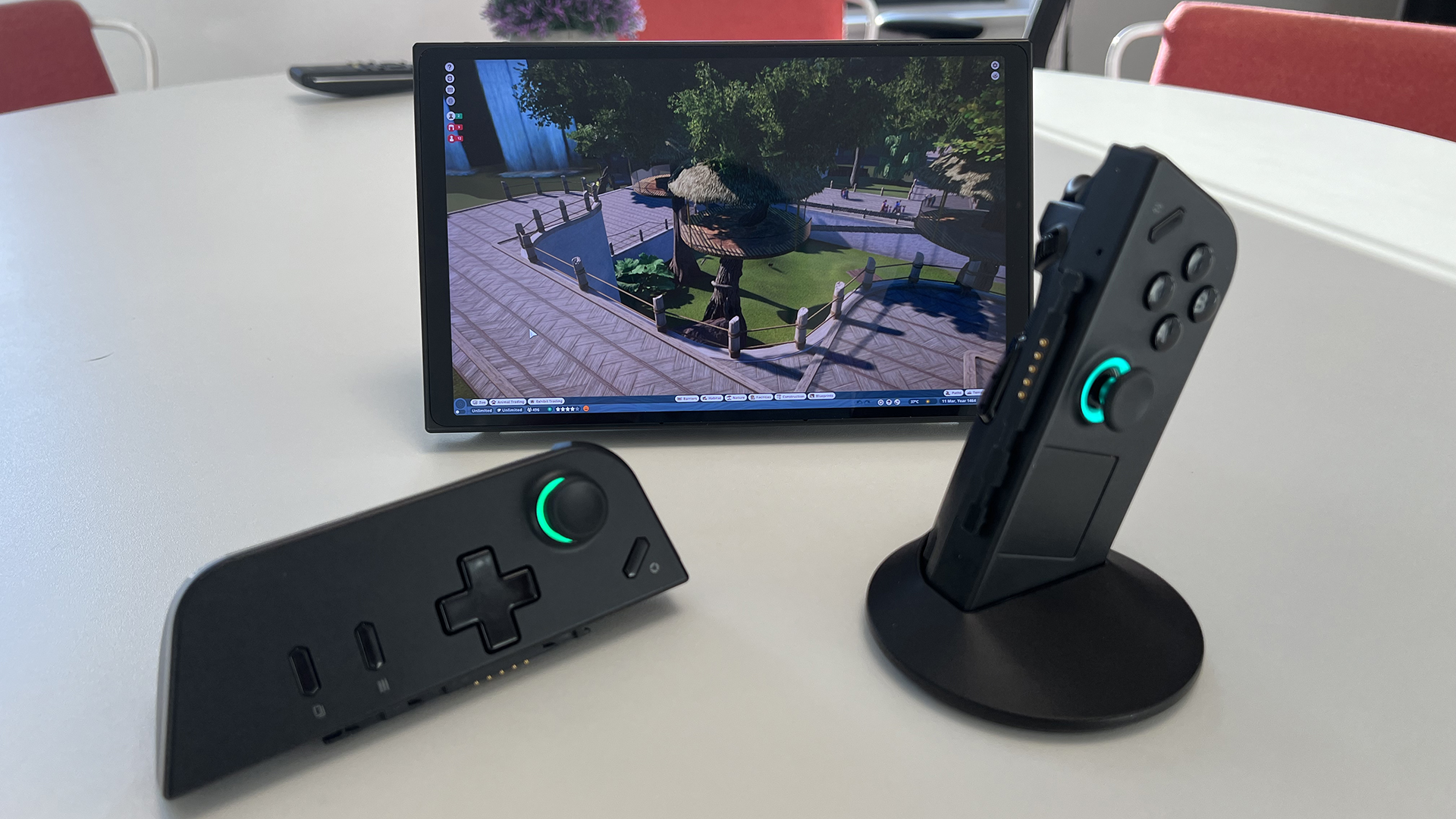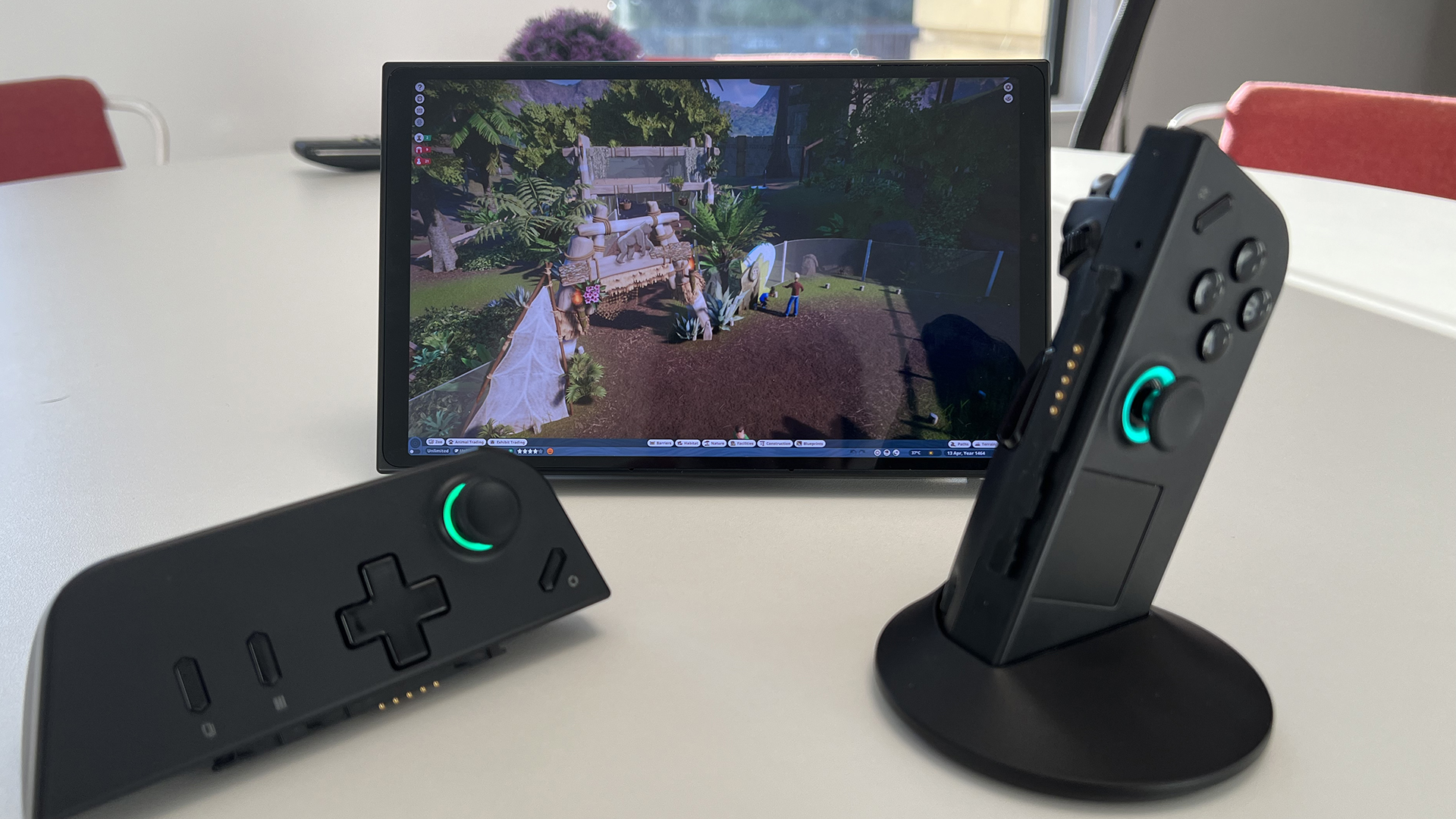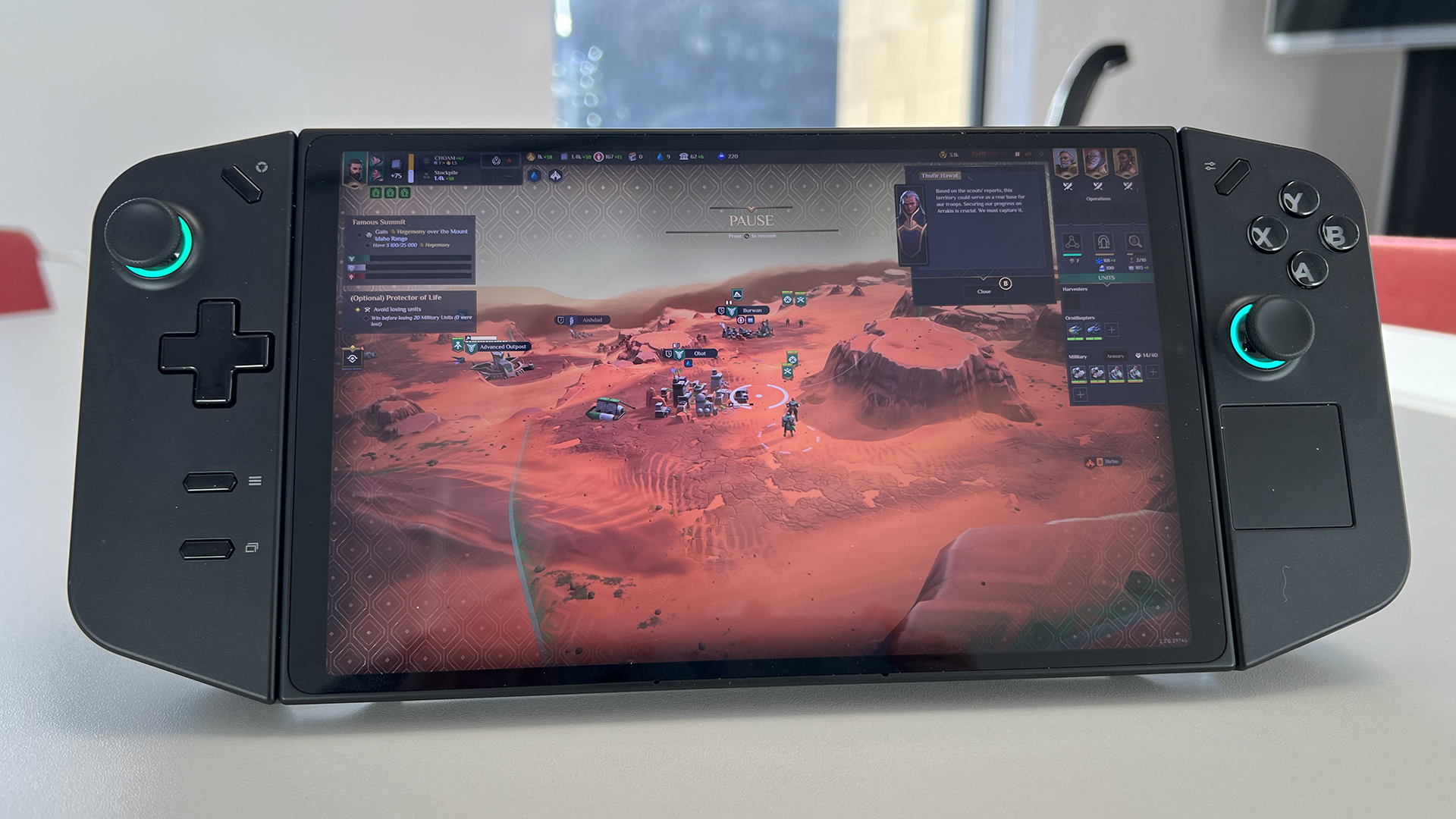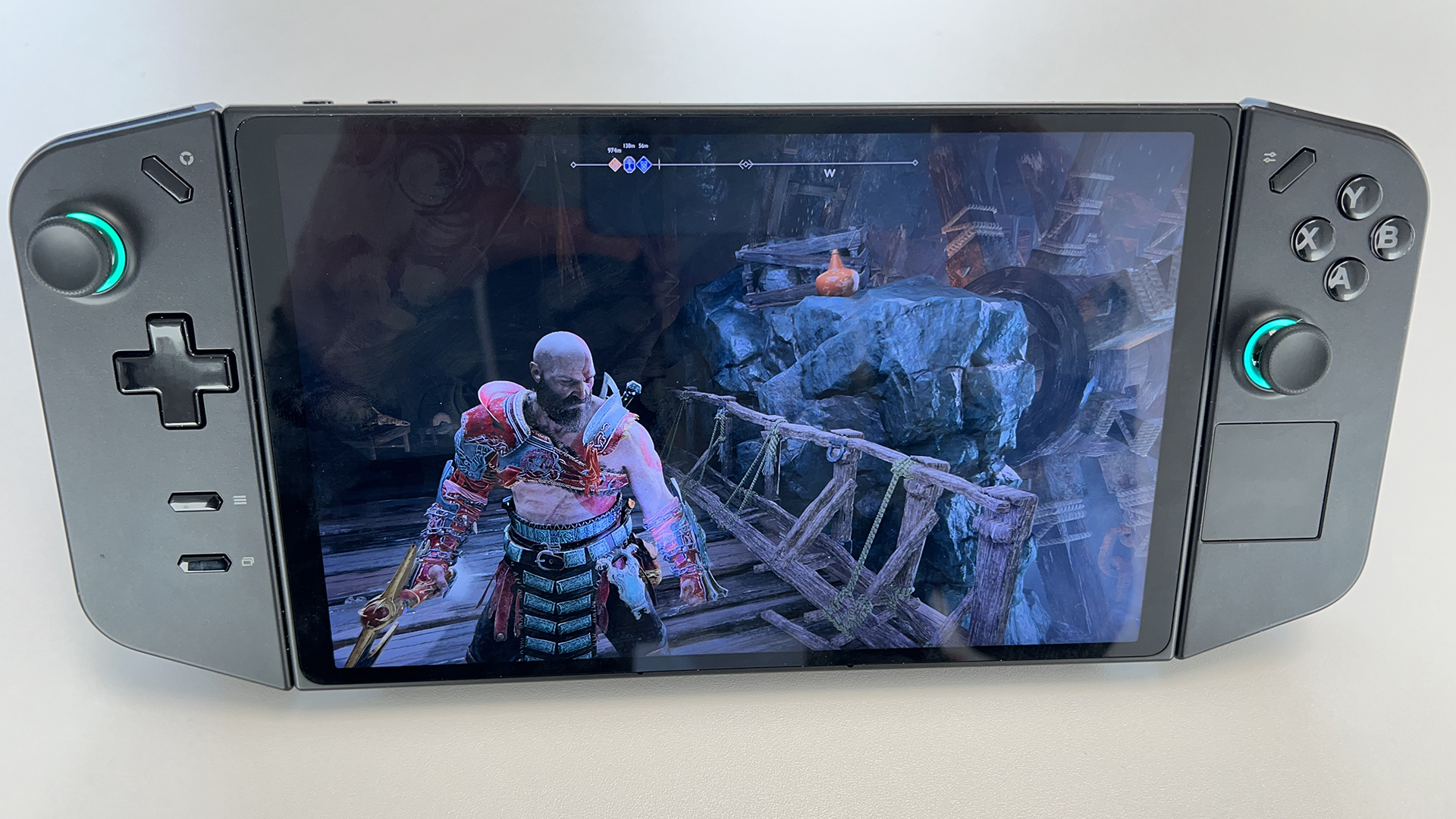Lenovo Legion Go review: power play
With a gorgeous 8.8in screen and super-power CPU, Lenovo’s new handheld offers top-tier gaming on the go


While you won’t necessarily be playing Alan Wake 2 at Ultra settings, the Lenovo Legion Go is a portable gaming powerhouse that can make many recent games shine. And despite the odd niggle with controls and software, its innovative ‘Switch-but-with-a-mouse’ format makes it a master for a range of gaming genres.
-
+
High-refresh rate screen and powerful CPU
-
+
Windows 11 makes it more flexible
-
+
Gorgeous-looking design
-
-
Average battery life
-
-
Some game streaming issues
-
-
Controllers feel plasticky, mapping is inflexible
Why you can trust T3
If you love playing modern games while on the go, Lenovo’s new gaming handheld should be high up your wishlist. As this Lenovo Legion Go review will make clear, it’s a strong candidate for one of the best gaming handhelds on the market. And while that’s rapidly becoming a crowded field, the Legion Go does enough things differently that it really deserves your consideration.
Now cards on the table – I’m a huge handheld gaming nerd. I’ve been glued to my Steam Deck ever since it arrived 18 months ago and it travels with me literally everywhere I go. So naturally I jumped at the chance to try out an even more powerful handheld gaming system, especially from a brand with the gaming credentials of Lenovo.
Has the Lenovo Legion Go lived up to my sky-high expectations? In most of the ways it counts, yes. It offers high-octane hardware, flexibility and ease of use that puts many of its rivals in the shade. But I would also argue that there are some rough edges that need sanding out if it’s to become a true gaming classic.
Lenovo Legion Go: Price & Availability
The Lenovo Legion Go was first unveiled on 1 September 2023 and is available to buy now directly from Lenovo. It currently retails for £700 in the UK, $699 in the US and $1,099 in Australia.
That does make it quite a bit more spendy than some of its nearest competitors. The Asus ROG Ally is already reduced to £599 / $599 / $1,299, meaning that – for all but Aussie gamers – the Lenovo Legion Go is going to have to do something pretty impressive to justify the increased cost. Fortunately, with some caveats, it absolutely delivers on this front.
Lenovo Legion Go review: features & setup

Now, I’ll be honest here. I’m coming to the Lenovo Legion Go from the Steam Deck. So the idea that you can install software in anything under a full evening, a whole bunch of FlatPak and copious amounts of tears seems pretty revolutionary to me. But thanks to the fact it runs on Windows 11, setting up and installing software on the Legion Go is both familiar and easy.
When you first boot it up, you’ll be dropped straight into Lenovo Space, the Legion Go’s built-in library. Should you want to, you can buy games straight from the Game Store tab and get playing. If you’re sensible though, you’ll want to add your existing game libraries first – this is as simple as tapping the Popular Gaming Platforms tab, adding your chosen library and… ping! You’re ready to start downloading games from across your umpteen different games libraries.
Get all the latest news, reviews, deals and buying guides on gorgeous tech, home and active products from the T3 experts
And I’m not exaggerating here. Just want to use the Lenovo Legion Go as a more powerful Steam device? Go ahead: your whole library is right at your fingertips. But there’s way more choice available and you can pull down all those random purchases you’ve been making across those different proprietary stores. Want to download stuff from Epic? Ubisoft Connect? The Xbox store? No problem! Even GoG’s niche store is available, offering access to a hoard of PC classics. Playing old gems like Theme Hospital or Dungeon Keeper while I sit on the Tube? Don’t mind if I do.
Of course, you might have your eye on more demanding fare than 25-year-old DOS games. Fortunately, even if you have an appetite for AAA new releases, you should have plenty of options. While games streaming is possible on the Steam Deck via the desktop browser and GeForce Now, it’s much easier to access on the Lenovo Legion Go, thanks to the fact that Xbox Game Pass is built right into Windows – not to mention the fact the console comes with a free trial. Once you’ve signed up for an account, you can download or stream any of the store’s current 149 PC games, from Warhammer 40,000: Darktide to Cities: Skylines II. This should mean you can continue to access cutting-edge games even as the Legion’s hardware ages.
With such a focus on third-party game launchers, you might wonder whether you absolutely need Lenovo Space. Well, wonder no more: you really don’t. Games shortcuts are added to the Windows start menu; meanwhile each time you load a game from a different library, said library opens in parallel and can be easily accessed via the taskbar. Do I appreciate having all of my games stored in one easily accessible and gamepad-friendly library? Sure. Did I spend half of my time just booting games direct from Steam or Epic? Of course. Still, even if it never felt all that essential, I did appreciate having a central hub to head to sometimes, especially when using things in handheld mode.
Clearly, there’s a wide array of games available on the Lenovo Legion Go but, if anything, there’s even more ways to play them. Perhaps the biggest headline feature is the device’s controllers. While the Nintendo Switch arguably whet consumers’ appetites for consoles they could take on the go, no brand has quite managed to rival its sheer flexibility. Up until now, that is.

Like most of its rivals, you can use the Lenovo Legion Go in handheld mode or hook it up to your TV using a USB-C to HDMI cable. You can also disconnect its controllers with the press of a button, kick out its adjustable stand and use it in tabletop mode, offering that ‘play anywhere’ feel that made the Switch such a versatile console to use. But Lenovo isn’t content to just ‘yes and…’ the innovations of others. You can also stick one of the controllers into a supplied cradle to use it like a vertical mouse – dubbed ‘FPS mode’, this unlocks a world of PC gaming that might otherwise have been a stretch on a handheld console.
In terms of hardware, it’s got some impressive specs. It’s packing an AMD Ryzen Z1 Extreme CPU, one of the 4nm processors AMD specifically designed to power handheld gaming PCs. Combining eight of AMD’s Zen 4 CPU cores and 12 of RDNA 3 graphics cores, this beast should mince the Steam Deck’s Zen 2 and, while you can get it in the ROG Ally, you’ll need to buy the higher-spec model.
The Lenovo Legion Go’s ColdFront thermal technology is equally impressive. Using ultra-thin heatsink fins, it’s able to keep the console cool even despite its compact form. Meanwhile, its fan can run at less than 25dB in quiet mode or ramp up to 30W TDP cooling when you’re really pushing for the burn.
Finally, it has pretty great connectivity for a handheld, offering not just one but two USB-C 4 ports, so you can power your console and hook it up to a TV or monitor at the same time. It’s also compatible with Wi-Fi 6E and is billed as ‘starting’ with Bluetooth 5.1, suggesting further updates may be on the way.
Lenovo Legion Go review: design

Naturally, tastes vary when it comes to gaming hardware. While some gamers like their rigs and laptops to look like a Cybertruck that’s crashed into a Las Vegas casino, I tend to prefer gadgets that don’t always need to be the centre of attention. So that’s worth bearing in mind when I say I personally feel that the Lenovo Legion Go is gorgeous. The customisable RGB lighting around the thumbsticks and on switch give it just the right amount of flare, making it feel appropriately futuristic while also remaining classy and understated.
Everything else is finished in a black plastic that really helps the lighting and screen pop. And the matte finish feels pleasant to the touch, although both it and the Gorilla glass screen are fingerprint magnets – a microfibre cloth and a screen protector is certainly a good idea if you want to keep it pristine.
That IPS touchscreen is a big part of the aesthetic appeal for me. At 8.8-inches, the Lenovo Legion’s display dwarfs the ROG Ally’s 7 inches and the Steam Deck’s 7.4 inches and the Lenovo's tiny, almost invisible bezels mean very little comes between you and the games you’re playing. And while it isn’t OLED, like that of the upgraded Steam Deck, its 2560 x 1600 resolution makes everything look super-crisp and the peak 500 nit brightness means I never really found myself struggling to make things out in bright light.
Easily the most exciting thing about that display though is its 144Hz variable refresh rate. Visuals in most games run smoother than a freshly buffed Burt Reynolds and you no longer feel like you’re sacrificing fluid motion just for the sake of switching to a smaller screen. And should you want to preserve battery or push the graphics of games to their limit, you can easily toggle it down to a more modest 60Hz.
Of course, such a big screen coupled with all that hardware and advanced cooling comes with a trade-off. This is a big device all round, measuring 299 x 131 x 40.7mm and weighing 854g. Stick it next to the Steam Deck – hardly a slip of a thing itself – and the difference is immediately appreciable. However, despite this, I never really found its bulk to be a block to lengthy gaming sessions. Whether that’s because of its well-engineered ergonomics or the Stockholm syndrome I’ve developed from so much time using bigger and bigger devices, I could not tell you.
The Lenovo Legion Go’s form factor really does feel versatile as well – this is the closest any handheld console has gotten to recreating the magic I experienced when docking my Nintendo Switch for the first time. Handheld mode will naturally be your default for a lot of games, but swapping between modes is nice and fluid. Click a release catch near the bottom of each controller and you’re ready to use them wirelessly in tabletop or TV mode. This doesn’t feel quite as smooth as with the Switch though – given the size of the Lenovo console, you aren’t just going to be able to slip them out one-handed like you can with Nintendo’s Joy-Cons.

Switching into FPS mode is just as easy. Once you’ve removed the controllers, you just switch a toggle on the right hand controller and stick it in its cradle to turn it into a full-fledged optical mouse. Not only does it feel precise to use but it’s pleasingly ergonomic – its vertical position and slight angle mean it’s comfortable to use for long periods. Personally, I didn’t use it much for FPS games – I’ve never really needed the extra edge a mouse can unlock for Call of Duty or Doom – but I did love the extra precision it offered for strategy games like Dune: Spice Wars or for more retro PC titles.
Rather than analogue thumbsticks, Lenovo has included Hall effect thumbsticks in the Legion Go. These are lag-free and, in theory, immune to the stick drift that has plagued a lot of recent controllers. Having binned my fair share of Joy-Cons and Xbox pads over the years, it is nice to know that the vertigo caused by spinning cameras is finally a thing of the past.
There are a few niggles with the controller setup though. First of all, while the console itself feels sturdy and substantial in Handheld mode, I couldn’t help but feel the disconnected controllers felt a bit hollow and plasticky. I guess that’s unsurprising – for Lenovo to keep the weight of the console down this low, every spare gram had to be trimmed. But it did make me miss the more compact, substantial feel of the Joy-Cons.
And despite good ergonomics generally, some odd choices have been made here and there. Even when you’re in-game, Lenovo has reserved the buttons either side of the top of the screen for system menus, while the in-game menus are awkwardly shunted down the bottom side of the left-hand controller. Not only did this mean I was constantly fighting my muscle memory when trying to access game menus, the times I did remember I still had to awkwardly reach down with my thumb – not what you want when attempting to quickly save in the middle of a firefight.
Controls generally could also still use some work too. Anything designed for play on an Xbox layout works beautifully but as soon as you move out of this sweet spot, it begins to show some frayed edges. When playing a desktop RPG like Skyrim in FPS mode, multiple common keys weren’t mapped, meaning I had to navigate back and forth between in-game controls and Legion Space menus to be able to pick up all those sweet rolls. It gave me real pangs for the simplicity of Steam’s community controller layouts, where the vast majority have perfectly fleshed-out defaults right out of the gate.
These quirks become even more noticeable as you move between different ecosystems. Much though I would have liked to have tested out cloud gaming on the Lenovo Legion Go, controller issues made this impossible. Every time I tried to boot up a game in the Xbox Cloud Gaming app, it would either fail to recognise the Legion Go’s controllers as an Xbox pad and refuse to launch or the controllers would be entirely unresponsive once it had. Perhaps this is to be expected with a service like Xbox Cloud Gaming, given it’s still in beta, but it’s still frustrating to find native Windows apps that simply don’t recognise the Legion Go’s controllers.
Lenovo Legion Go review: performance

Given Lenovo’s pedigree in the gaming space, my expectations for what the Lenovo Legion Go would be able to do were pretty high. And, generally speaking, it effortlessly Fosbury flopped over that high bar.
Part of this is down to all that hardware it has under the hood – those AMD Ryzen Z1 Series chips mean the Lenovo Legion Go has some serious oomph behind it. Running our standard benchmarking tests in Geekbench 6, it achieved a single-core score of 1948 and a multi-core score of 7843. Comparing this to the Steam Deck’s respective scores of 1313 and 4496 makes one thing clear – the Lenovo is unquestionably a beast of a handheld.
This is immediately appreciable in its overall performance. Boot up in balance mode and most games run silky smooth. Mid-weight games look genuinely impressive by default, experience almost no perceptible lag and, as long as you don’t have the graphical settings set too high, that 144Hz refresh rate makes the action glide like Torvill and Dean skating through an oil slick.
Switch to Performance mode and you can ramp up those settings a lot further. In God of War, I was able to push up all of the settings to Ultra, which made it look absolutely gorgeous and showed off the nine realms in all of their beauty. Naturally, that meant accepting a trade-off in terms of performance, but at least you’re able to toggle down the refresh rate to save some battery. And it’s impressive to see what the Lenovo Legion Go was capable of doing when pushed.

Eager to test this to its absolute limit, I downloaded Bethesda’s brand new space RPG Starfield. It honestly felt a little troll-ish downloading a true AAA game to such a compact console – it’s something that would make even my ageing gaming rig experience a midlife crisis, so I didn’t really expect it to run on the Lenovo Legion Go. But blow me down: it not only runs but it’s actually pretty playable. Handsome it wasn’t but getting it running at all on a console like this, even if it’s on rock bottom graphics settings, was seriously impressive.
It is worth noting here though that this kind of high-octane performance only comes while the console is plugged into the mains. When running off the battery, more jank starts to creep in with super-demanding graphics settings – at this point the frame rate started dropping low enough for Starfield to look like an Isaac Asimov flipbook. But that’s hardly surprising: the power drain to keep the CPU and fans ticking over at this rate is significant and it’s inevitable some throttling would occur to extend battery life.
This kind of granular control also extends to the console’s cooling, meaning you can dial the fans up and down as needed for the demands of your games. Most of the time, the Lenovo Legion Go is a pretty cool customer – its fans scarcely make a peep during casual gaming. Naturally, this changes during more demanding gaming modes; to keep its innards nice and frosty, you’ll want to dial up its thermal mode to 30W, which does kick out a lot more noise. And if you’re really worried about cooking its CPU during an intensive gaming sesh, you can always toggle on Full Fan Speed – although this does sound a little like a nuclear reactor powering up.
The sheer flexibility of the Lenovo Legion Go’s performance means that its battery life can vary quite wildly. Lenovo estimates that the battery can last up to 7.1 hours but this will only apply to the most casual of games – in reality it never lasted anywhere near that long during my testing. During a laid-back session of Planet Zoo on balanced settings, I was able to eke 1.75 hours of gameplay out of its two-cell 49.2WHr battery. Conversely, while playing Starfield and really cranking those fans, I was able to stretch its battery out for around 75 minutes. All told, while it’s someway short of what was promised, it’s still not all that bad, especially compared to the 40Whr battery of the LCD Steam Deck – which barely outlasts my lunch hour while playing much less demanding titles.
When you top it up again, the Lenovo Legion Go supports Super Rapid Charging, which Lenovo predicts will get you up to 70% of the battery’s capacity from a 30 minute charge. Personally I found this a little generous – plugging the console into the mains seemed to give me about 10% charge in 15 minutes and 46% after an hour. Again, this isn’t bad for a battery of this size but it’s not going to blow anyone away.
Lenovo Legion Go review: verdict

The Lenovo Legion Go has thrown down a gauntlet for other gaming handhelds. In terms of sheer power, it can’t be beat. Not only does it allow you to access much more demanding games on the go but it also unlocks a broader range of games, thanks to the high-compatibility of Windows and the inclusion of its innovative mouse control. Its user experience might not always be as polished as the Steam Deck’s, but it offers way more possibilities and that’s to be celebrated.
Are there some wrinkles to work out? Sure. Battery life seems to be a perennial problem with gaming handhelds and the Lenovo Legion Go hasn’t quite managed to smash this barrier yet. As with all of its predecessors, there’s still work to be done to make controller profiles as broad and versatile as possible. And the Cloud Gaming issues I experienced do slightly temper my enthusiasm about its flexibility to fill all mobile gaming niches. But at least the latter two issues can and most likely will be fixed in future updates, which means the Lenovo Legion Go should have a bright future ahead of it.
Ultimately, the main issue you’re going to come up against is cost: this is likely more expensive than an equivalently powered home-built desktop rig would be and is nipping at the heels of the cheapest gaming laptops. However, I do think that’s comparing crabapples and grapefruit – they differ in size as well as kind. Anyone considering a handheld console is looking for a sweet spot between power, price and shove-in-a-bag portability and few products sit so neatly in the centre of that Venn diagram than the Lenovo Legion Go.
Also consider
As you may have picked up from the references liberally drizzled throughout this review, the clearest alternative to and archest rival of the Lenovo Legion Go is undoubtedly the Steam Deck OLED. It doesn’t have quite the processing power of the Legion Go and navigating Linux on the odd occasion you want to install third-party mods or games is a pain. But that screen offers gorgeously deep blacks and the sheer intuitiveness of SteamOS makes it a dream for just-pick-up-and-play gaming.
If you’re after something that offers the same kind of power and user-friendliness as the Lenovo Legion Go without as much markup, the Asus ROG Ally is the obvious choice. It rocks the same high-octane AMD Ryzen Z1 Extreme CPU and also runs off Windows 11, meaning you can easily install apps and games to your heart’s content. Getting that price down does mean accepting some compromises though: its screen is much smaller at 7-inches and you won’t get the flexibility of the Legion Go’s detachable controllers.